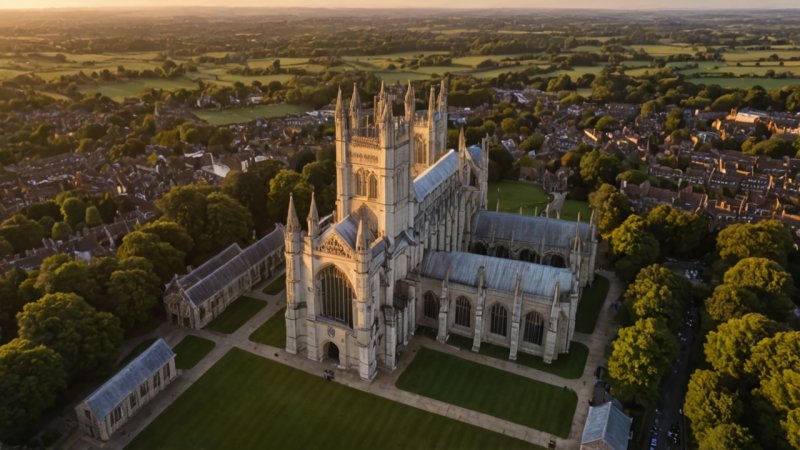Winchester Cathedral, one of the largest cathedrals in Europe, stands as a magnificent testament to medieval architecture and a rich tapestry of history. Nestled in the heart of Winchester, England, this iconic structure has been a place of worship for over a thousand years and has witnessed significant events that have shaped England's cultural and religious landscape. From its stunning Gothic design to its historical significance, Winchester Cathedral is a must-visit for anyone intrigued by architecture, history, or spirituality.
History of Winchester Cathedral
The history of Winchester Cathedral dates back to 642 AD when it was founded by Saint Birinus, the first bishop of Wessex. The original structure, a small church, underwent several transformations over the centuries. The current cathedral, built primarily between 1079 and 1532, showcases a blend of Norman and Gothic architectural styles. It was initially constructed as a part of the Norman Conquest's influence, symbolizing the church's power and the monarchy's authority.
Throughout its history, the cathedral has served various purposes. It was a burial site for several English kings and queens, including King Alfred the Great, and has hosted numerous significant events, such as the coronation of Henry I in 1100. The structure has also survived various challenges, including the dissolution of monasteries under Henry VIII, which led to its temporary decline before undergoing restoration efforts in the 19th century.
Architectural Features
Winchester Cathedral is renowned for its striking architectural features, which reflect the evolution of English Gothic architecture. The building spans an impressive length of 557 feet and boasts the longest nave of any Gothic cathedral in Europe. Here are some key architectural highlights:
- Nave: The nave is the heart of the cathedral, characterized by its soaring ceilings and intricate stonework. The high vaulted ceiling, made of wooden panels, creates a stunning atmosphere of grandeur and tranquility.
- Stained Glass Windows: The cathedral features an extraordinary collection of stained glass windows, some dating back to the 12th century. These windows depict biblical stories and saints, casting colorful light throughout the interior.
- Chapter House: The Chapter House, with its unique circular design, served as a meeting place for the clergy. Its beautifully decorated ceiling and intricate stone carvings make it a highlight of the cathedral.
- Romanesque and Gothic Elements: The blend of Romanesque and Gothic architectural styles is evident throughout the cathedral, with rounded arches coexisting with pointed ones, showcasing the transition in architectural design during its construction.
Significant Artifacts and Memorials
Inside Winchester Cathedral, visitors can find numerous artifacts and memorials that provide insight into England's history. Some notable highlights include:
- The Winchester Bible: This magnificent 12th-century illuminated manuscript is considered one of the greatest treasures of the cathedral. It was commissioned by the then-bishop and is renowned for its intricate illustrations and calligraphy.
- Tomb of Jane Austen: The famous author Jane Austen is buried in the cathedral, and her memorial can be found near the nave. The inscription pays tribute to her literary contributions and legacy.
- Memorials of Kings and Bishops: The cathedral is the final resting place for several notable figures, including King Alfred the Great and Bishop William of Wykeham. Their memorials serve as a reminder of the significant impact they had on English history.
Visitor Information and Tips
If you're planning a visit to Winchester Cathedral, here are some essential tips to enhance your experience:
- Opening Hours: The cathedral is typically open to visitors throughout the week. However, it's advisable to check the official website for current opening hours and any special events.
- Admission Fees: While entry to the cathedral is free, a small donation is encouraged to help with the maintenance and preservation of this historical site.
- Guided Tours: Consider joining a guided tour to gain deeper insights into the cathedral's history and architecture. Knowledgeable guides can provide fascinating anecdotes that may not be evident during a self-guided visit.
- Photography: Photography is allowed in most areas of the cathedral, but be respectful of others and avoid using flash in dimly lit areas.
Unique Experiences at Winchester Cathedral
Beyond the architectural marvels and historical significance, Winchester Cathedral offers unique experiences that enhance your visit:
- Seasonal Events: The cathedral hosts various seasonal events, including Christmas carol services, Easter celebrations, and special exhibitions. Participating in these events provides a chance to experience the cathedral in a different light.
- Music and Concerts: The acoustics of the cathedral make it a suitable venue for concerts and musical performances. Attending a choral service or concert can be a memorable experience, showcasing the cathedral's remarkable sound.
- Prayer and Reflection: The tranquil atmosphere of the cathedral provides an ideal space for prayer and reflection. Visitors can take a moment to pause, meditate, or simply enjoy the serenity of the surroundings.
Exploring the Surrounding Area
Winchester Cathedral is not the only attraction in Winchester. The city itself is steeped in history and offers several other sites worth exploring:
- Winchester Castle: Just a short walk from the cathedral, this historic castle once served as a royal residence and now hosts the Great Hall, home to the legendary Round Table of King Arthur.
- Wolvesey Castle: The ruins of this medieval palace, once the residence of the bishops of Winchester, are located nearby and provide a glimpse into the past.
- Jane Austen's House: A short drive from Winchester, the house where Jane Austen spent the last years of her life is now a museum dedicated to her life and works.
Conclusion
Winchester Cathedral is more than just a historical landmark; it is a living testament to the architectural and cultural evolution of England. Its majestic structure, rich history, and the stories of the people it has housed make it a must-visit destination for travelers seeking to immerse themselves in the past. Whether you're an architecture enthusiast, a history buff, or simply looking for a peaceful place to reflect, Winchester Cathedral offers a unique experience that will leave a lasting impression.






